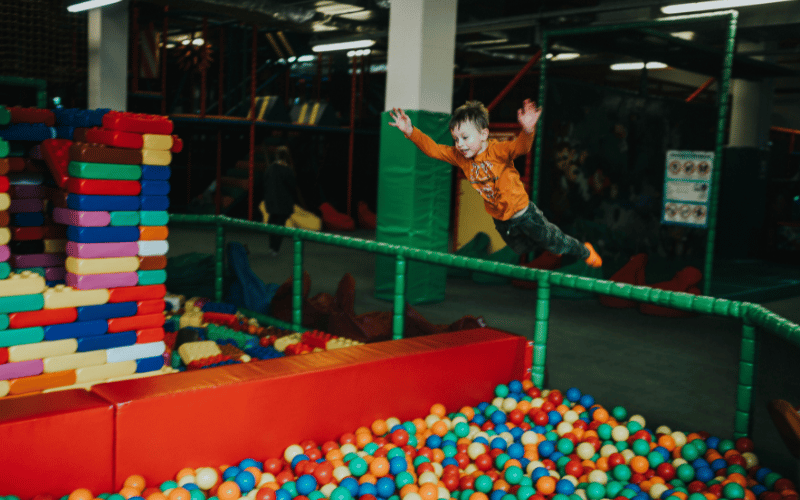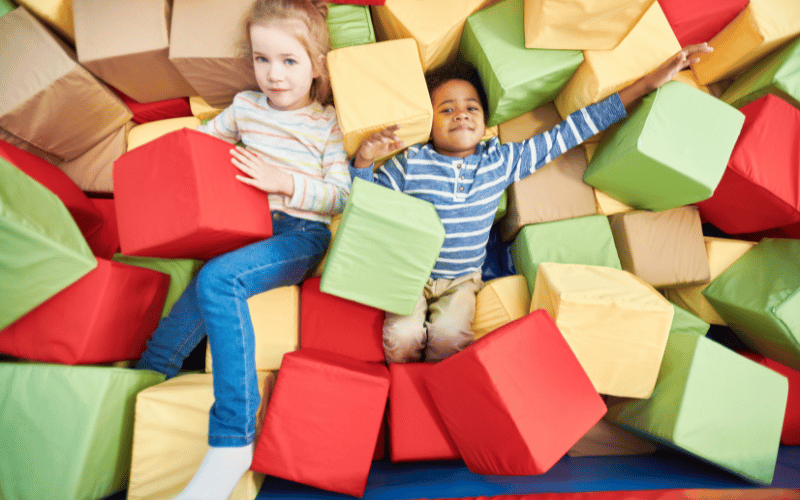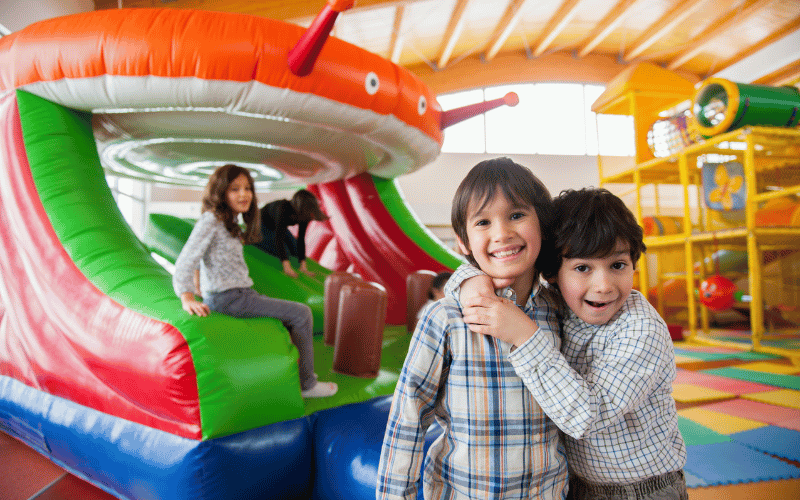Indoor playgrounds are gaining popularity as businesses recognize their potential to attract families and generate revenue. Proper planning plays a crucial role in ensuring success. In this guide, you’ll discover actionable steps, expert tips, and common pitfalls to avoid when creating a thriving indoor play space.
Table of Contents
ToggleUnderstanding the Indoor Playground Market
The indoor playground market is a dynamic and ever-evolving industry, offering exciting opportunities for both businesses and families. To truly grasp its potential, it’s essential to understand what indoor playgrounds are, why they’re gaining popularity, and the trends shaping their growth.
What Is an Indoor Playground?
An indoor playground is more than just a play area—it’s a sanctuary of fun, learning, and exploration for children. These spaces are designed with safety and creativity in mind, featuring soft foam mats, colorful tunnels, and interactive play structures that encourage physical activity and imaginative play. For parents, indoor playgrounds offer peace of mind, providing a secure environment where their children can thrive without the risks associated with outdoor hazards, such as traffic or adverse weather conditions.
Why Are Indoor Playgrounds Popular?
The popularity of indoor playgrounds has skyrocketed in recent years, and it’s no mystery why. In an era where screens often dominate children’s attention, parents are seeking alternatives that encourage physical activity and social interaction. Indoor playgrounds answer this call by providing a safe, weatherproof environment where kids can run, jump, and climb to their hearts’ content. They also cater to the modern parent’s busy lifestyle, often incorporating amenities like cafes, Wi-Fi, and seating areas, making them a win-win for families.

Market Trends and Demographics
The indoor playground market is booming, with a current global market size valued at billions and projected to grow at a steady rate of 10-12% annually over the next decade. This growth is fueled by increasing urbanization, rising disposable incomes, and a growing awareness of the importance of active play in child development.
Key demographics include families with children aged 2-12, with a particular focus on urban and suburban areas where outdoor play spaces may be limited. Millennials, now the primary generation of parents, are especially drawn to indoor playgrounds that offer educational and sensory-rich experiences for their children.
Types of Indoor Playgrounds
Indoor playgrounds come in various shapes and sizes, each catering to different needs and preferences:
- Soft Play Areas: These are ideal for toddlers and younger children, featuring padded surfaces, ball pits, and gentle slides that prioritize safety and sensory exploration.
- Adventure Parks: Designed for older kids, these spaces often include climbing walls, obstacle courses, and zip lines, offering a more physically challenging experience.
- Themed Centers: From pirate ships to space stations, themed playgrounds immerse children in imaginative worlds, enhancing their creative play.
- Hybrid Models: Combining elements of play, education, and entertainment, hybrid playgrounds often incorporate interactive exhibits, STEM activities, or even mini-arcades, appealing to a broader age range and encouraging longer family visits.
Planning Your Indoor Playground Business
Launching an indoor playground business is an exciting venture, but success requires careful planning and attention to detail. From crafting a solid business plan to navigating legal requirements, every step plays a crucial role in building a thriving operation.
Developing a Business Plan
Think of your business plan as the blueprint for your indoor playground—it’s the foundation upon which everything else is built. Start with a thorough market analysis. Research your local area to identify demand, competition, and gaps in the market. For example, are there underserved neighborhoods with young families? What types of play facilities are already available, and how can yours stand out?
Next, dive into financial projections. Calculate startup costs, including equipment, lease expenses, and initial marketing efforts. Then, estimate your revenue streams, such as admission fees, birthday party packages, and café sales. Be realistic but optimistic—investors and lenders will want to see a clear path to profitability.
Finally, outline your marketing strategies. Will you focus on social media campaigns, partnerships with local schools, or community events? A well-rounded plan ensures you’re prepared to attract and retain customers from day one.
Choosing the Right Location
The location of your indoor playground can make or break your business. Look for spaces that are highly visible and easily accessible, such as near shopping centers, schools, or residential areas. Ample parking is a must—parents won’t want to struggle to find a spot when juggling kids and strollers.
Demographics are equally important. Study the local population to ensure there’s a high concentration of families with young children. For example, a suburban area with a growing number of new housing developments might be a prime spot. Additionally, consider the size and layout of the space. High ceilings and open floor plans are ideal for accommodating play structures and creating a welcoming atmosphere.
Funding Your Business
Starting an indoor playground requires a significant upfront investment, but there are multiple ways to secure funding. On average, startup costs can range from $100,000 to $500,000, depending on the size and scope of your facility. This includes expenses for equipment, lease deposits, interior design, and initial marketing.
Explore funding options such as small business loans, which often come with competitive interest rates. Alternatively, consider bringing on investors who share your vision and can provide both capital and expertise. Crowdfunding is another avenue, especially if you can rally community support by highlighting the benefits your playground will bring to local families.

Legal and Regulatory Requirements
Navigating the legal landscape is a critical step in setting up your business. Start by registering your business with the appropriate government agencies and obtaining any necessary permits. For example, you may need zoning approval to operate in your chosen location.
Insurance is non-negotiable. At a minimum, you’ll need general liability insurance to protect against accidents and injuries, as well as property insurance for your equipment and facility. Additionally, familiarize yourself with safety regulations and building codes. This might include installing fire exits, ensuring play structures meet safety standards, and maintaining proper sanitation protocols.
Designing Your Indoor Playground
Designing an indoor playground is like crafting a child’s dream world—every detail matters. From the layout to the equipment and additional amenities, each element should work together to create a space that’s safe, engaging, and functional for both children and their parents.
Creating a Functional Layout
A well-thought-out layout is the backbone of any successful indoor playground. Start by dividing the space into zones tailored to different age groups. For instance, toddlers need a soft play area with low structures and sensory toys, while older kids thrive in zones with climbing walls, obstacle courses, or adventure slides. This separation not only enhances the play experience but also ensures safety by preventing collisions between children of varying ages.
Visibility is another critical factor. Parents and staff should have clear sightlines across the entire facility. Arrange play structures in a way that minimizes blind spots, and consider using low partitions or transparent barriers to maintain supervision without disrupting the flow of the space. Additionally, ensure pathways are wide enough to accommodate strollers and foot traffic, creating a seamless experience for families.

Selecting Equipment
Choosing the right equipment is where your playground truly comes to life. Prioritize safety and durability above all else. Look for equipment that meets recognized safety standards, such as ASTM or EN certifications, and is made from high-quality, non-toxic materials. For example, steel frames with powder-coated finishes resist wear and tear, while UV-resistant plastics maintain their vibrancy over time.
Age-appropriate options are equally important. For toddlers, consider soft foam blocks, mini slides, ball pits, crawl tunnels, and sensory mats that encourage exploration and motor skill development. For older children, climbing nets, rope bridges, interactive play panels, monkey bars, and spiral slides can provide the challenge and engagement they crave. Additionally, features like zip lines, obstacle courses, and trampoline zones can add an extra layer of excitement for adventurous kids.
Don’t forget to incorporate inclusive equipment to ensure your playground is welcoming to all children. Sensory play panels, wheelchair-accessible ramps, adaptive swings, and quiet zones for children with sensory sensitivities can make your space more inclusive and appealing to a broader audience. By offering a variety of equipment, you can create a dynamic and engaging environment that caters to children of all ages and abilities.

Incorporating Safety Features
Safety isn’t just a feature—it’s the foundation of your indoor playground. Start with certified safety flooring, such as rubber tiles or poured-in-place surfaces, which provide cushioning to reduce the impact of falls. Padding should also be applied to any hard edges, such as support beams or corners of play structures.
Regular maintenance is key to keeping your playground safe. Establish a routine for inspecting equipment, tightening bolts, and replacing worn-out components. Additionally, clear signage with safety rules and age recommendations can help guide parents and children, reducing the risk of accidents.
Adding Ancillary Services
To elevate your indoor playground from a play space to a family destination, consider adding ancillary services that cater to both children and parents. Party rooms are a must-have, as they provide a dedicated space for birthday celebrations and other events, generating additional revenue for your business.
A café or snack bar can keep parents comfortable and engaged while their children play. Offer a mix of kid-friendly snacks and healthier options, along with coffee and seating areas where parents can relax. Parent-friendly spaces, such as quiet zones or workstations with Wi-Fi, can further enhance the experience, making your playground a go-to spot for families.
Operations and Management
Running an indoor playground is as much about efficient operations as it is about creating a fun and safe environment. From staffing to pricing, every operational detail contributes to the overall success and sustainability of your business.
Staffing Your Playground
Your staff are the heart and soul of your playground, ensuring that every visitor has a safe and enjoyable experience. When hiring, look for individuals who are not only great with children but also have strong communication and problem-solving skills. A friendly demeanor goes a long way in creating a welcoming atmosphere for families.
Training is non-negotiable. Equip your team with comprehensive knowledge of safety protocols, such as supervising play areas, handling minor injuries, and responding to emergencies. Customer service training is equally important—staff should be prepared to handle everything from a toddler’s tantrum to a parent’s inquiry about party packages. Regular team meetings and refresher courses can help maintain high standards and keep everyone aligned.
Implementing Safety Protocols
Safety is the cornerstone of your operations, and it requires a proactive approach. Start with daily inspections of all equipment and play areas. Train staff to check for loose bolts, worn-out padding, or any other potential hazards. Keep a detailed log of these inspections to ensure accountability and track recurring issues.
Emergency preparedness is another critical component. Develop clear plans for scenarios like medical emergencies, fire evacuations, or lost children. Conduct regular drills to ensure staff know their roles and can act quickly under pressure. Additionally, establish a rigorous cleaning schedule to maintain hygiene and prevent the spread of germs—parents will appreciate the attention to cleanliness.
Insurance and Liability
Protecting your business from potential risks is essential, and that starts with securing the right insurance coverage. General liability insurance is a must, as it covers accidents and injuries that may occur on your premises. Property insurance protects your equipment and facility from damage caused by events like fires or natural disasters.
Don’t overlook workers’ compensation insurance, which provides coverage for your employees in case of workplace injuries. Consult with an insurance professional to ensure you have adequate coverage tailored to the unique risks of an indoor playground. It’s also wise to have a legal expert review your liability waivers and signage to ensure they comply with local regulations.
Pricing and Bookings
Setting the right pricing structure is a balancing act—you want to remain competitive while ensuring profitability. Start by researching local competitors to understand the market rate for admission fees and party packages. For example, you might offer tiered pricing, such as discounted rates for toddlers or family passes for multiple children.
Party packages are a significant revenue stream, so design them to appeal to a variety of budgets. Include options for basic packages with just playtime and cake, as well as premium packages with decorations, catering, and party hosts.
Streamline the booking process by offering an online reservation system. Parents value convenience, and a user-friendly platform for booking play sessions, parties, or memberships can set you apart from competitors. Include features like automated reminders and the ability to reschedule, which can enhance the customer experience.
Marketing and Growth
Marketing your indoor playground is about more than just attracting customers—it’s about building a brand that families trust and love. By combining strategic branding, local outreach, and creative promotions, you can establish a strong presence and set the stage for long-term growth.
Building Your Brand
Your brand is the personality of your business, and it should resonate with both children and parents. Start by creating a memorable identity, including a playful yet professional logo, a cohesive color palette, and a tagline that captures the essence of your playground. For example, a tagline like “Where Fun Meets Adventure” can instantly communicate your mission.
A user-friendly website is non-negotiable in today’s digital age. Ensure your site is mobile-friendly, easy to navigate, and includes essential features like online booking, pricing details, and FAQs. Add high-quality photos of your facility to give potential customers a glimpse of the fun they can expect. Don’t forget to integrate social media links to encourage engagement and build an online community.
Local Marketing Strategies
Local marketing is the lifeblood of an indoor playground, especially when you’re just starting out—partner with nearby schools, daycare centers, and community organizations to spread the word. For instance, you could offer discounted group rates for school field trips or sponsor local youth events to build goodwill.
A grand opening event is a fantastic way to make a splash in your community. Plan activities like free play sessions, face painting, or giveaways to draw in families and create buzz. Use local advertising channels, such as community newspapers, radio stations, and bulletin boards, to promote your event and reach your target audience.

Promotions and Events
Promotions and events keep your playground top of mind and encourage repeat visits. Seasonal events, like Halloween-themed play days or summer camps, can attract families looking for unique experiences. Birthday packages are another key offering—design customizable options that cater to different budgets and preferences, such as themed decorations or private playtime.
Loyalty programs are a proven way to retain customers. For example, you could offer a punch card system where families earn a free visit after a certain number of paid admissions. Email newsletters and social media campaigns can also be used to share exclusive discounts, upcoming events, and special offers, keeping your audience engaged.
Expanding Your Business
Once your playground is running smoothly, it’s time to think about growth. Adding new services, such as educational workshops or sensory play sessions, can attract a broader audience and increase revenue. For example, hosting STEM-themed play days could appeal to parents looking for educational activities for their children.
If your first location is thriving, consider opening additional locations in nearby areas with similar demographics. Alternatively, explore franchising opportunities to expand your brand while leveraging the resources and expertise of franchisees. Whichever path you choose, ensure that your core values and quality standards remain consistent across all locations.
FAQs
Q: What certifications are required for indoor playground equipment?
A: Indoor playground equipment must meet specific safety standards to ensure the well-being of children. Look for certifications such as ASTM (American Society for Testing and Materials) or EN (European Norms) standards, which verify that the equipment has undergone rigorous testing for safety and durability. Additionally, check for certifications related to fire resistance and non-toxic materials to comply with local regulations.
Q: How much space is needed for a small indoor playground?
A: A small indoor playground typically requires a minimum of 1,500 to 2,000 square feet. This space allows for essential play structures, seating for parents, and pathways for easy movement. If you plan to include additional features like party rooms or a café, you’ll need to allocate extra square footage. Always consider the ceiling height as well—at least 12-15 feet is ideal for accommodating larger play structures.
Q: What are the typical operating hours for an indoor playground?
A: Most indoor playgrounds operate from 9:00 AM to 7:00 PM, catering to families during mornings, afternoons, and early evenings. Weekends often see extended hours to accommodate birthday parties and peak visitation times. Some facilities also offer special early access for members or private bookings outside regular hours.
Q: How do you ensure cleanliness and safety?
A: Maintaining cleanliness and safety requires a proactive approach. Staff should clean and sanitize play areas, equipment, and high-touch surfaces multiple times a day using child-safe cleaning products. Daily inspections of equipment help identify and address wear and tear before it becomes a hazard. Clear safety rules, such as age restrictions for certain areas, should be prominently displayed, and staff should actively supervise play to prevent accidents.
Q: What is the average return on investment for an indoor playground business?
A: The average return on investment (ROI) for an indoor playground business typically ranges from 20% to 30% annually, depending on factors like location, pricing, and additional revenue streams such as party packages or memberships. Most businesses recover their initial investment within 2-3 years if they maintain consistent customer traffic and manage expenses effectively.
Conclusion
Starting a successful indoor playground business requires careful planning and execution. Focus on key steps like conducting thorough market research, choosing the right location, designing a functional and safe space, and implementing effective marketing strategies. Take the first step today by diving into market research or consulting with industry experts who can guide you through the process. Begin crafting your business plan, outline your budget, and start reaching out to trusted suppliers to bring your vision to life. With the right preparation and determination, you can create a thriving indoor playground that becomes a cherished destination for families in your community.






